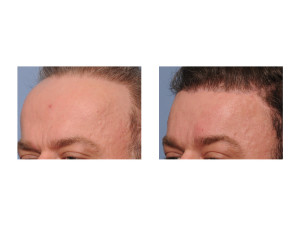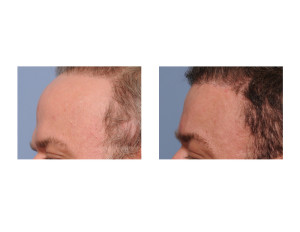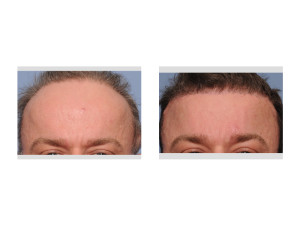Background: The shape of the forehead is affected by various hard and soft tissue components. The forehead is framed by the hairline superiorly, the brows inferiorly and the bony temporal lines to the sides. The projection of the forehead is controlled by the thickness of the frontal bone and its degree of convexity and smothness. The height of the forehead is judged by the vertical distance from the hairline to the brow.
Vertical forehead reduction can be of benefit when the hairline to brow distance is about 6.5 cm and longer. Numbers aside, one knows when the forehead is too long by their own aesthetic sense. Shortening the length of the forehead is done by moving the hairline forward or more inferior through extensive scalp undemining and mobilization. A powerful procedure, the hairline or scalp advancement can make a dramatic difference in the appearance of the upper third of the face.
Bony forehead reduction is done to either narrow the shape of the forehead or eliminate any obvious bony projections. This is a bone burring technique that is usually done to narrow the width of the forehead, reduce the amount of its forward projection (convexity) or smooth down so called forehead horns. This almost always need to be done through an open approach afforded by a hairline incision.
Case Study: This 40 year male had a long forehead due to receding frontal hairline and a wide and bulging forehead due to its bony shape. He had a prior hair transplant procedure with a linear strip scar on the back of his head. His desire was for a shorter forehead length and a less wide and bulging forehead.


Many patients with high and long foreheads have a combination of a posteriorly recessed hairline and bony forehead bossing. Preoperative computer imaging will show whether the apparent forehead bossing is a function of just a high forehead and an exposed upper forehead bony contour or whether a true excessive forehead convexity exists. A very wide or broad forehead in the frontal view, however, is an excessive bony width problem for which a hairline advancement will not improve.
Highlights:
- Forehead bossing is treated by bony reduction of forehead width and projection. (forehead contouring)
- Vertical forehead reduction is a soft tissue procedure where hairline advancement is done. (scalp advancement)
- Total forehead reduction is when both bony and soft tissue procedures are done simultaneously.
Dr. Barry Eppley
Indianapolis, Indiana



